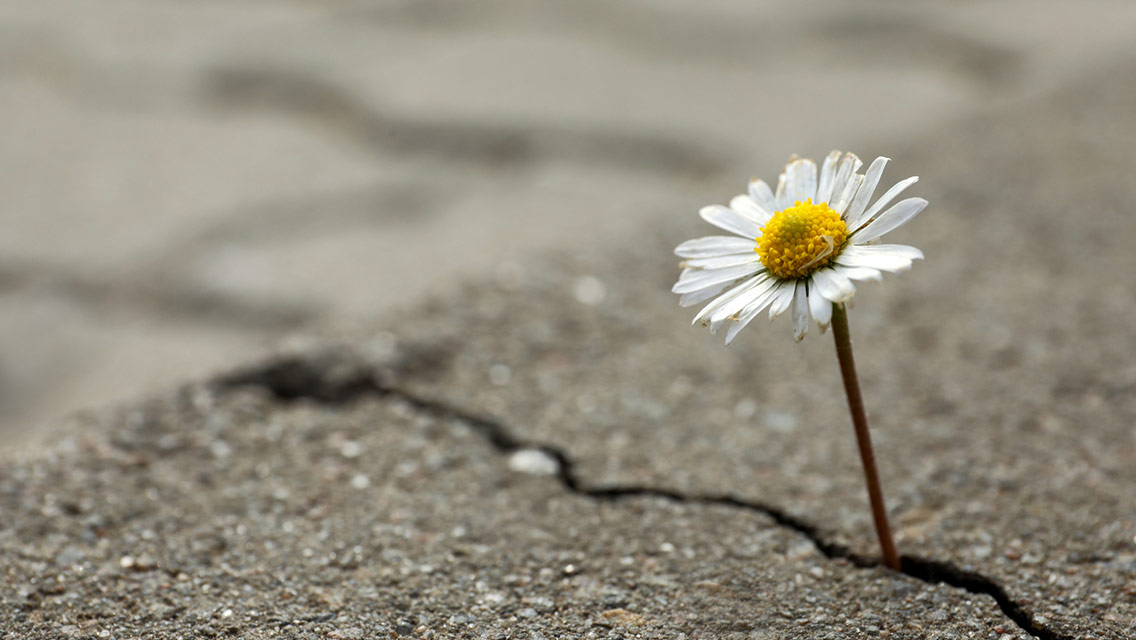Victoria Ruvolo was driving home from a niece’s piano recital one wintery evening in 2004 when a large object smashed through her windshield, hitting with such force that it broke every bone in her face. The object turned out to be a frozen turkey. The thrower: a teenage boy named Ryan Cushing, out for a joyride with friends in a stolen car. Ruvolo’s passenger managed to grab the steering wheel, push Ruvolo’s foot off the gas pedal and steer them onto the shoulder. After being rushed to the hospital, Ruvolo remained in an induced coma for two weeks.
When it was safe to operate, the doctors began painstakingly putting Ruvolo back together. The then-44-year-old office manager from Long Island was left with three titanium plates in her left cheek, one plate in her right cheek, and a screen holding her left eye in place. Her family was told that she might have permanent brain damage and was unlikely to be capable of living on her own.
But that wasn’t a prediction Ruvolo was ready to accept. She had survived tragedies before. Two of her brothers died in separate incidents when she was a teenager. At age 35 she miscarried a much-longed-for child. Somehow, she had found the strength to come through those losses, and she was determined that she would make it through this one, too.
Somehow, she had found the strength to come through those losses, and she was determined that she would make it through this one, too.
With a devastated face, and a questionable future ahead of her, Ruvolo had plenty of good reasons to sink into anger and depression. But she didn’t. Instead, even as she was still undergoing a series of reconstructive surgeries, she told herself, “This moping isn’t going to get me anywhere.” And she turned her focus to learning more about Ryan Cushing, the boy responsible for her ordeal. What could she learn about him that would help her understand the accident?
Ruvolo discovered that Cushing was in the midst of his own turmoil: His father had just left his mother for another woman. He had serious vision problems that left him unable to play sports or drive a car. Months later, when Ruvolo went to the troubled boy’s sentencing, she mystified many by working with the district attorney’s office to encourage a lenient sentence.
“I just couldn’t see how locking him up for 25 years was really going to help him,” says Ruvolo. The judge agreed, and Cushing was sentenced to six months in jail and five years of probation. Ruvolo’s empathy toward Cushing wasn’t the only surprising post-incident event: Contrary to her grim prognosis, she was back at work within eight months, living on her own, and speaking regularly to at-risk youths about ways to improve their lives.
Looking back, Ruvolo realizes she showed similar resiliency after her brothers’ deaths and her miscarriage. But where does this kind of resiliency come from? And why don’t more of us have it? That is a question that has kept researchers busy for decades. Why is it, they’ve wondered, that some people seem to bounce back from traumas with relative ease — even thriving after negative events — while others crack and crumble?
The answers are compelling. In his best-selling book, The Resiliency Advantage, the late Al Siebert, PhD, writes that “highly resilient people are flexible, adapt to new circumstances quickly, and thrive in constant change. Most important, they expect to bounce back and feel confident that they will. They have a knack for creating good luck out of circumstances that many others see as bad luck.”
Siebert also notes that resilient people are adept at seeing things from another person’s point of view — just as Ruvolo was able to do with Cushing. When we empathize with others, we feel less alone and less entrenched in pain. As a result, we recover faster.
Resilient people are adept at seeing things from another person’s point of view.
Psychologists agree that some people seem to be born with more resilience than others. But they also assert that it’s possible for all of us to cultivate more of it. One key is adjusting how we think about adversity.
A long-term study of 99 Harvard men showed that the way people view negative life events (as fixed and unchangeable vs. temporary and subject to influence) predicted their physical health five — and even 35 — years later. But a boost to physical health isn’t this mindset’s only upside. Darcy Smith, PhD, a clinical social worker in Manhattan, explains: “Resilience refers to our capacity to deal with discomfort and adversity, but it’s not just a reactive skill set. The same characteristics that make us resilient are traits that enrich our lives.”
Want to bolster your own inherent resilience? Here, according to top researchers, are the five most powerful ways to go about it.
No. 1: Pump Up Your Positivity
“In our research program, we found that the daily repertoire of emotions of people who are highly resilient is remarkably different from those who are not,” says Barbara Fredrickson, PhD, the author of Positivity.
Resilient people are characterized by an ability to experience both negative and positive emotions even in difficult or painful situations, she says. They mourn losses and endure frustrations, but they also find redeeming potential or value in most challenges.
When not-so-resilient people face difficulties, Fredrickson notes, all of their emotions turn negative. If things are good, they feel good, but if things are bad, they feel horrid.
Resilient people, on the other hand, tend to find some silver lining in even the worst of circumstances. While they certainly see and acknowledge the bad, Fredrickson says, “they’ll find a way to also see the good. They’ll say, ‘Well at least I didn’t have this other problem.’”
Resilient people, on the other hand, tend to find some silver lining in even the worst of circumstances.
She notes that this is different than succumbing to Pollyanna-ish denial. “The resilient person isn’t papering over the negative emotions, but instead letting them sit side by side with other feelings. So at the same time they’re feeling ‘I’m sad about that,’ they’re also prone to thinking, ‘but I’m grateful about this.’”
But what if this sort of well-balanced emotional response doesn’t come naturally to you? You can change that, says Fredrickson. But it will mean challenging your reflexive thoughts, and your self-talk. (See “6 Difficult Emotions and How to Deal With Them” for more guidance.)
“Thinking patterns trigger emotional patterns,” she explains. “So to change emotional patterns, sometimes what we need to do is curtail our negative thinking and stoke our positive thinking.
“Say you find yourself ruminating on negative thoughts,” she says. “For instance: I’ll never succeed in my career. Ask yourself, ‘What’s the evidence that I’ll never succeed?’ You might say, ‘Well, there’s this history of success and this history of failure.’ How does that add up to never? It’s a matter of getting really literal about the kinds of blanket statements we have in our self-talk.”
Because of built-in survival mechanisms, our brains are naturally wired to pay more attention to negative events than positive ones. But in reality, we experience positive events with much greater frequency. One key to building resiliency, says Fredrickson, lies in noticing and appreciating those positive experiences whenever and wherever they occur.
“What matters most is your positivity ratio,” she says. That ratio is a product of how you characterize the balance of positive and negative experiences in your daily life. Fredrickson’s research suggests that, at minimum, we need a 3-to-1 ratio of positive to negative experiences not just to build resilience, but also to thrive, be optimally productive and enjoy our lives.
“This means that for every heart-wrenching negative emotional experience you endure, you have to experience at least three heartfelt positive emotional experiences that uplift you. Three to one appears to be the tipping point, predicting whether people languish or flourish.
No 2: Live to Learn
The more you can leverage challenges as opportunities to grow and evolve, the more resilient you are likely to be. “Pain comes to all of us in life,” says David Sabine, PhD, a clinical psychologist in Wichita Falls, Texas. “What I see resilient people do is immediately look at the problem and say, ‘What’s the solution to that? What is this trying to teach me?’ Looking at pain as an opportunity to learn and problem-solve — and building the confidence and the habit of moving toward the pain instead of running from it — goes a long way in terms of building resiliency.”
Nancy Gruskin is an excellent example. In the spring of 2009, her husband, Stuart, was crossing a one-way, Midtown Manhattan street when he was struck by a bicyclist riding the wrong way. Stuart sustained a serious head injury in the accident. Three days later, he died. He was just 50 years old and the father of then-12-year-old twins.
For weeks Gruskin remained in an emotional fog, and understandably so. After a newspaper story was published about her experience, she received a flood of calls, emails and letters from people who’d been in similar, though less severe, situations. Hearing their stories ignited Gruskin to learn more about the issue. Diving into it gave her a sense of purpose and helped transform her pain. Eventually, it even empowered her to affect broad positive change: She partnered with Hunter College and started a foundation bearing her husband’s name that’s dedicated to developing safety awareness for pedestrians in urban areas. As a result of their hard work, New York City Mayor Michael Bloomberg signed a law into effect last February that requires the city to collect and keep data about bicycle-pedestrian accidents.
One strategy for cultivating a learner mindset is to use “question thinking,” a method of problem solving developed by psychotherapist and executive coach Marilee Adams, PhD. Question thinking encourages people to approach challenges and situations with “Learner Questions” — neutral, nonjudgmental questions such as “What is useful here?” or “What are my available choices?” — as opposed to “Judger Questions” like “What’s wrong?” or “Who’s to blame?”
Learner questions are empowering, and they promote more expansive thinking and acceptance. They also improve how you relate to others, and creating meaningful connections with others is yet another essential component of resilience. (For more on question thinking, read “Lines of Inquiry.”)
No. 3: Open Your Heart
Being of service to others is a powerful way of stoking resilience. “In studies, researchers found that serotonin [the neurotransmitter associated with feelings of happiness and well-being] is used more efficiently by people who have just engaged in an act of kindness,” says Sabine.
Acts of kindness, and the serotonin boosts that accompany them, have a cumulative effect. “Once you’ve added these things to your life in a consistent way, the benefits become exponential, so that in times of difficulty you’ve got this well of resiliency to draw upon,” says Sabine.
Acts of kindness can be formally organized, like regularly volunteering in a soup kitchen. Or, Sabine says, they can be “as simple as getting out there and finding people to smile at or speak an encouraging word to.”
It’s worth noting, though, that receiving and appreciating kindness from others may be just as important as offering it up, because gratitude turns out to be an important part of resiliency, according to clinical social worker Darcy Smith.
It’s worth noting, though, that receiving and appreciating kindness from others may be just as important as offering it up, because gratitude turns out to be an important part of resiliency.
When adversity strikes, gratitude for the things that are going right in your life helps put tragedy in perspective. “I often recommend that people start a 30-day gratitude journal,” she says. “Or get a few of your friends together and start a gratitude blog. I did that about a year ago. Every day we each blog about three things we’re grateful for.”
Another strategy for building gratitude comes from Fredrickson. Called “un-adapting,” it involves consciously drawing attention to the positive things in your life that you may have started taking for granted.
“Our emotions typically respond to dramatic changes, but a lot of good things — a roof over your head, the ability to feed your children, a career you enjoy — are stable. As a result, they fade into the background. So what you can do is deliberately draw your attention to them.”
She cites a study in which researchers asked married couples to “un-adapt” by thinking of how they might not have met (if one had decided not to go to the grocery store that day or had turned down the blind date, for example). “Then the researchers compared the couples who imagined not meeting to a group of couples who instead were asked to tell the story of how they did meet,” continues Fredrickson. “Later, when quizzed about their satisfaction in the marriage, the people who thought about how they might not have met reported more satisfaction. Without un-adapting, the couples might have thought, ‘Well of course we met, we were destined to be together,’ which is a recipe for taking each other for granted.”
According to Fredrickson, when you take stock of how things might have been otherwise, instead of just how they are, you’re using strategic positive thinking to increase gratitude, which then builds resiliency.
No. 4: Take Care of Yourself
Good health — and a regular routine of healthy habits — are foundational to both mental and emotional resilience.
Just prior to the accident that crushed the bones in her face, Ruvolo had lost 60 excess pounds and substantially improved her fitness. “I was in the best physical condition I could possibly be in. I was all muscle,” she says. After she healed, doctors told Ruvolo that her excellent physical condition had certainly played a role in her almost-miraculous recuperation.
Daily habits count: When you’re caught up on sleep, eating well and keeping stress levels low, you’ll be less fragile and less likely to fall into unhealthy patterns following a serious setback or tragedy.
But our physical resilience also depends heavily on our baseline mental and emotional well-being. And one of the best ways to nurture that, says Carol Orsborn, PhD, author of The Art of Resilience: 100 Paths to Wisdom and Strength in an Uncertain World, is to take regular mental breaks: “It could be something as formal as a regular meditation practice,” she says, “or it could simply be letting yourself daydream.”
Research shows that our brains are surprisingly active in moments when we appear to be doing little. PET and MRI images of the brain “at rest” show that, in fact, there is significant activity in the brain regions associated with decision-making, memories and the processing of emotionally significant events.
When active, this “default network,” uses up to 30 percent more caloric energy than other parts of the brain. Researchers surmise that energy is being used to process all the experiences and information we’ve taken in, and to develop new synaptic connections. In turn, those synaptic networks improve our ability to solve and respond to problems.
Mental breaks and relaxation also help keep stress chemicals at bay, reducing the likelihood of feeling, or becoming, overwhelmed and reactive.
Mental breaks and relaxation also help keep stress chemicals at bay, reducing the likelihood of feeling, or becoming, overwhelmed and reactive.
Two other key self-care factors that help nurture resilience: Spending time outdoors and surrounding yourself with people you enjoy.
Research suggests that spending just 20 minutes outside in nice weather leads to “more expansive and open thinking,” writes Fredrickson — a pro-resiliency mindset. Other studies have shown that time in nature helps combat anxiety and depression, improves immunity, and lowers levels of inflammatory chemicals in the body.
A similarly convincing body of research shows that strong social connections increase our resilience in the face of illness. One 2006 study of nearly 3,000 nurses with breast cancer found that those with 10 or more friends were four times more likely to survive the disease than the nurses without close friends.
No. 5: Hang on to Humor
There’s a reason that the late Norman Cousins relied on Marx Brothers comedies as a primary treatment for his debilitating illness. It’s the same reason that some version of “gallows humor” and “comic relief” have probably been with us since the beginning of time: Laughing in the face of adversity can be profoundly pain relieving, for both the body and mind.
“Playful humor enhances survival for many reasons,” writes resiliency authority Al Siebert in The Survivor Personality. For one thing, he notes, “Laughing reduces tension to more moderate levels.” And psychologically, choosing levity can be incredibly empowering. “Playing with a situation makes a person more powerful than sheer determination [does],” Siebert explains. “The person who toys with the situation creates an inner feeling of ‘This is my plaything; I am bigger than it . . . I won’t let it scare me.’” (See “The Surprising Benefits of Laughter — and Tips to Find More of It” for more.)
Ruvolo credits a sense of humor with helping her rebound as well. And she thanks her mother for that: “My mom was big on laughter,” Ruvolo says. “She always said that you have to keep laughing. My mother lost two sons, and yes, she had a few problems, but she always laughed and she always told jokes. I truly believe that helps you to understand and to get through.”
Case in point: Ruvolo speaks once a month to troubled teens in a conflict resolution program. Toward the end of each session, she makes a joke about the frozen turkey that came through her windshield on a winter’s night and nearly killed her. “I tell the kids that now for the rest of my life I have to be known as the Turkey Lady. Thank God it was a turkey, and not a ham, because I would have been known as Miss Piggy.”
How Resilient Are You?
Resilience is the process of adapting to difficult or challenging life experiences, says the late Al Siebert, PhD, founder of The Resiliency Center in Portland, Ore. Curious to know how your own resilience rates? Take this quiz, adapted from Siebert’s book The Resiliency Advantage.
Rate yourself from 1 to 5 (1 = strongly disagree; 5 = strongly agree):
- I’m usually optimistic. I see difficulties as temporary and expect to overcome them.
- Feelings of anger, loss and discouragement don’t last long.
- I can tolerate high levels of ambiguity and uncertainty about situations.
- I adapt quickly to new developments. I’m curious. I ask questions.
- I’m playful. I find the humor in rough situations, and can laugh at myself.
- I learn valuable lessons from my experiences and from the experiences of others.
- I’m good at solving problems. I’m good at making things work well.
- I’m strong and durable. I hold up well during tough times.
- I’ve converted misfortune into good luck and found benefits in bad experiences.
Less than 20: Low Resilience — You may have trouble handling pressure or setbacks, and may feel deeply hurt by any criticism. When things don’t go well, you may feel helpless and without hope. Consider seeking some professional counsel or support in developing your resiliency skills. Connect with others who share your developmental goals.
20–30: Some Resilience — You have some valuable pro-resiliency skills, but also plenty of room for improvement. Strive to strengthen the characteristics you already have and to cultivate the characteristics you lack. You may also wish to seek some outside coaching or support.
30–35: Adequate Resilience — You are a self-motivated learner who recovers well from most challenges. Learning more about resilience, and consciously building your resiliency skills, will empower you to find more joy in life, even in the face of adversity.
35–45: Highly Resilient — You bounce back well from life’s setbacks and can thrive even under pressure. You could be of service to others who are trying to cope better with adversity.
Used by permission. © Copyright 2005 Practical Psychology Press, adapted from Chapter 2 in The Resiliency Advantage (Berrett-Koehler) by Al Siebert, PhD. All rights reserved.
This article has been updated. It was originally published online on September 1, 2011.



